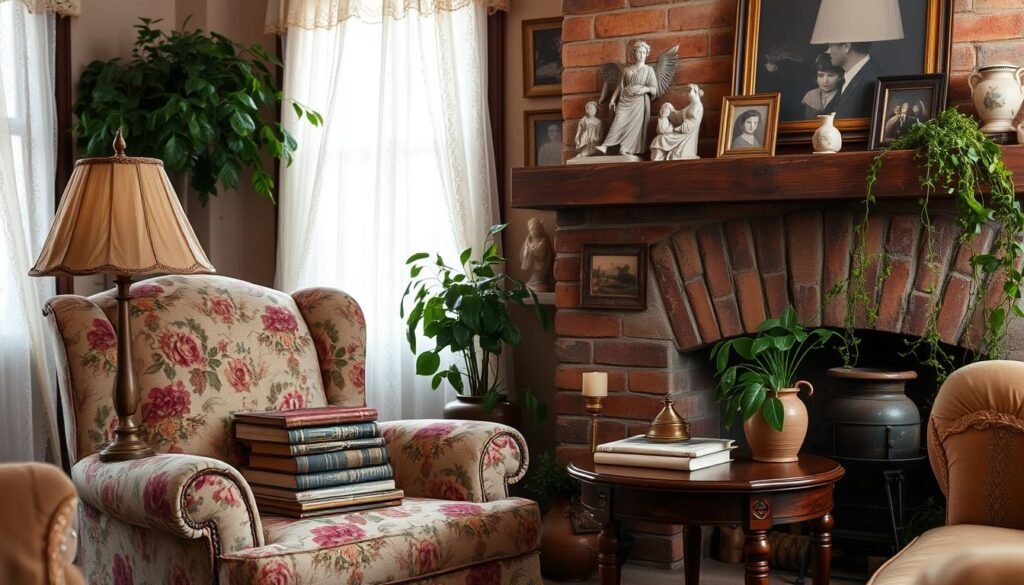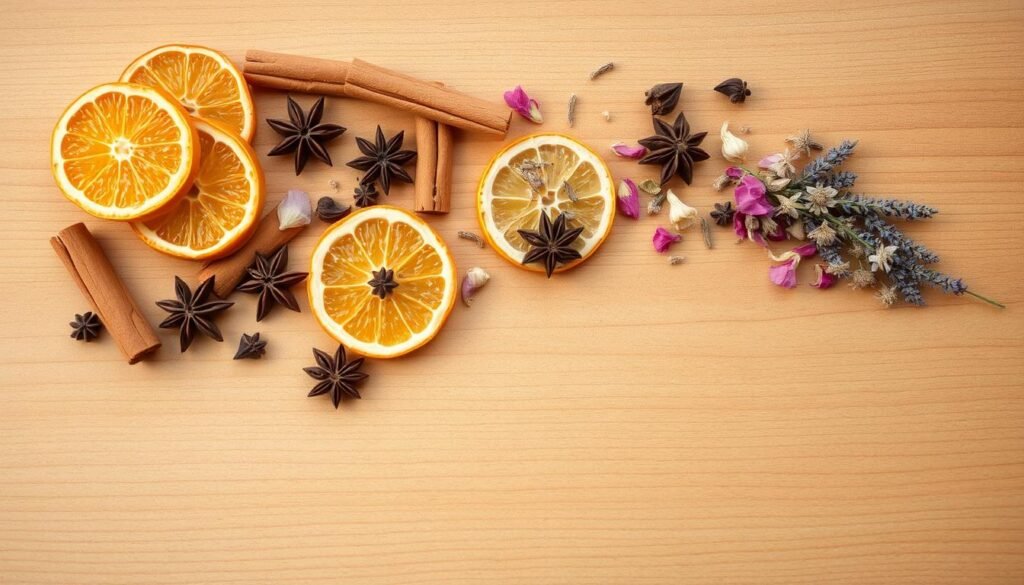Imagine walking into a room that feels like a curated collection of stories—each piece whispering tales of the past while adding soul to your present. That’s the magic of blending timeless elements into your living area. Forget cookie-cutter trends; this approach celebrates character over perfection, inviting warmth that new items simply can’t replicate.
Why do weathered finishes and gently used furnishings captivate us? They carry history in their seams—a coffee table with faint ring marks from decades of use, a lamp base with patina that glows like a sunset. These details create depth, turning your house into a conversation-starting haven.
Adopting this style requires a slight shift in perspective. Instead of chasing showroom-ready symmetry, you’ll learn to spot beauty in asymmetry and authenticity. Think of it as eco-conscious creativity—breathing new life into pre-loved finds while reducing waste (and often saving money).
What makes these treasures stand out? They’re one-of-a-kind. You won’t find duplicates at a friend’s place or in catalog spreads. Each choice reflects your personality, creating a look that’s uniquely yours without shouting for attention.
Ready to rethink how you design? Let’s explore how to mix textures, eras, and finishes to craft spaces that feel collected rather than decorated—where every item has purpose and poetry.
Understanding the Charm of Vintage Decor
Every scratch on a well-loved chair isn’t a flaw—it’s a fingerprint of history waiting to be rediscovered. These pieces become bridges between generations, carrying whispers of Sunday dinners and stories etched in time. That coffee table with water rings? It’s not damaged—it’s authentic.
The History and Significance of Vintage Pieces
True vintage items (think 1920s-1970s) showcase craftsmanship that outlasts trends. Each piece tells a story through its patina—the faded fabric from sunny windowsills, the drawer handle worn smooth by daily use. Makers used solid woods and metals that developed character over decades, creating heirlooms modern factories can’t replicate.
Distinguishing Vintage, Antique, and Retro
Let’s decode the labels:
- Vintage: At least 40 years old (anything pre-1980s today)
- Antique: 100+ years old (think pre-1920s)
- Retro: New items mimicking 20th-century styles
Why does this matter? That “antique” lamp from the 1950s is actually vintage—and knowing this could save you money at flea markets. These distinctions help you spot quality and avoid pricing traps.
Vintage Decor Ideas for Every Room in Your Home
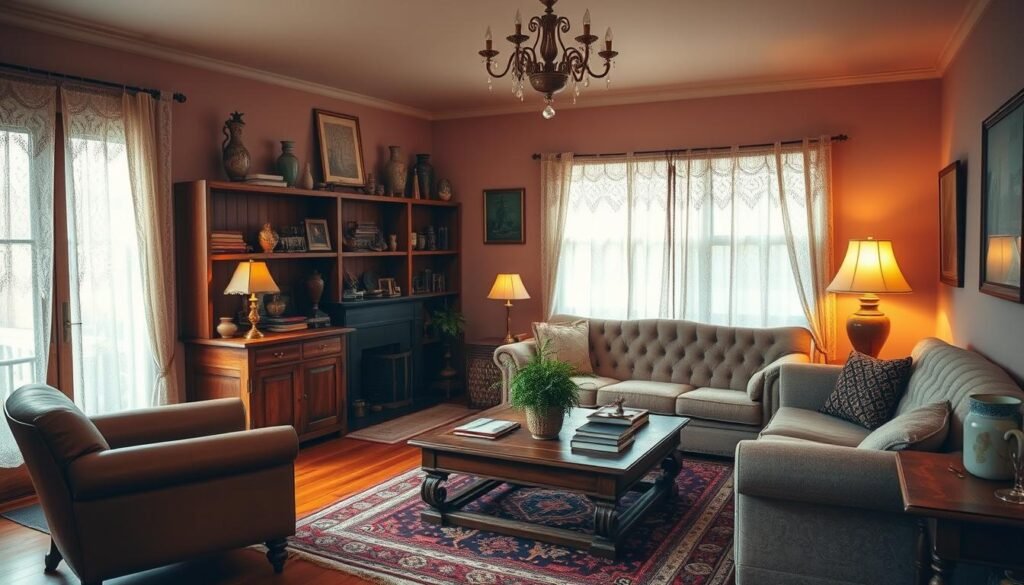
What if every corner of your home told a story? Transform your space by weaving character into each area—without turning it into a museum. Start with high-traffic zones like the living room, where conversation pieces shine brightest.
Selecting Unique Items for Key Spaces
Mix textures to create depth. Pair sleek linen curtains with a brass lamp that’s seen decades of use. This contrast makes both elements stand out—the crisp fabric balances the lamp’s warm patina.
Seasonal swaps keep things fresh. Display holiday-specific treasures like embroidered Thanksgiving napkins or mid-century glass ornaments during Christmas. These subtle touches add festive flair without clutter.
| Room | Aged Item | Modern Pairing | Effect |
|---|---|---|---|
| Living Room | Leather armchair (1960s) | Geometric throw pillow | Balances rugged & refined |
| Bathroom | Porcelain soap dish | Frosted glass shower door | Blends classic & contemporary |
| Bedroom | Wooden blanket ladder | Minimalist bed frame | Adds warmth to clean lines |
Repurpose thoughtfully. That chipped trunk becomes extra seating with cushions. Mount a salvaged ladder horizontally to display throws in the bedroom—functional and eye-catching.
In the bathroom, use mercury glass jars for cotton balls or a weathered tray to corral toiletries. These small upgrades turn utilitarian spaces into relaxing retreats.
Step-by-Step Guide to Creating a Timeless Look
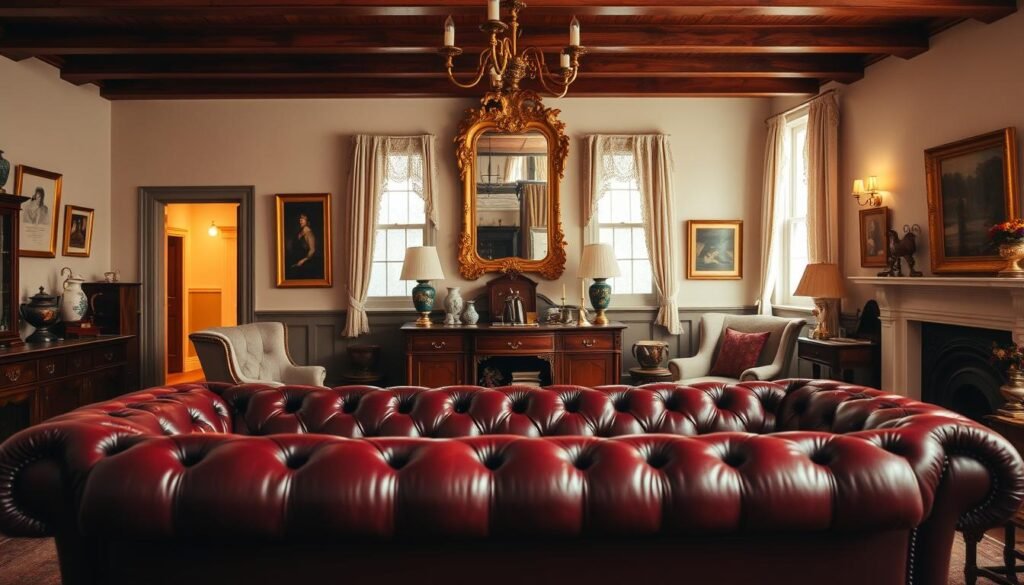
Transforming your space begins with intentional choices, not grand overhauls. Think of it as slow styling—building depth through pieces that spark joy or curiosity. The secret? Let each addition earn its place through meaning and visual appeal.
Starting Small: Local Finds and Heirlooms
Your journey starts at neighborhood antique shops. Look for items with conversation potential—like a weathered gas can repurposed as a floral centerpiece. These unexpected swaps create instant focal points. As one designer notes:
“The best rooms have at least one item that makes guests ask, ‘Where’d you find that?'”
Don’t overlook family attics. A survey by Home Heritage Institute found 63% of cherished home items come from relatives. That chipped picture frame? It becomes priceless when paired with your wedding photos.
Easy DIY Projects and Creative Repurposing
Breathe new life into finds with simple upgrades:
| Item | Transformation | Materials Needed |
|---|---|---|
| Old books | Stacked side table | Wood glue, clear sealant |
| Vintage suitcases | Nested storage | Fabric liner, felt pads |
| Framed embroidery | Wall art grouping | Command strips, level |
Stick to neutral paint colors for backgrounds—soft greys or warm ivories let aged details shine. For furniture with worn edges, try beeswax polish instead of full refinishing. It preserves history while preventing further wear.
Remember: Your space should evolve like a photo album—each addition capturing a moment or memory. Start with one meaningful piece, then build outward as confidence grows.
Mixing Vintage with Modern Home Decor
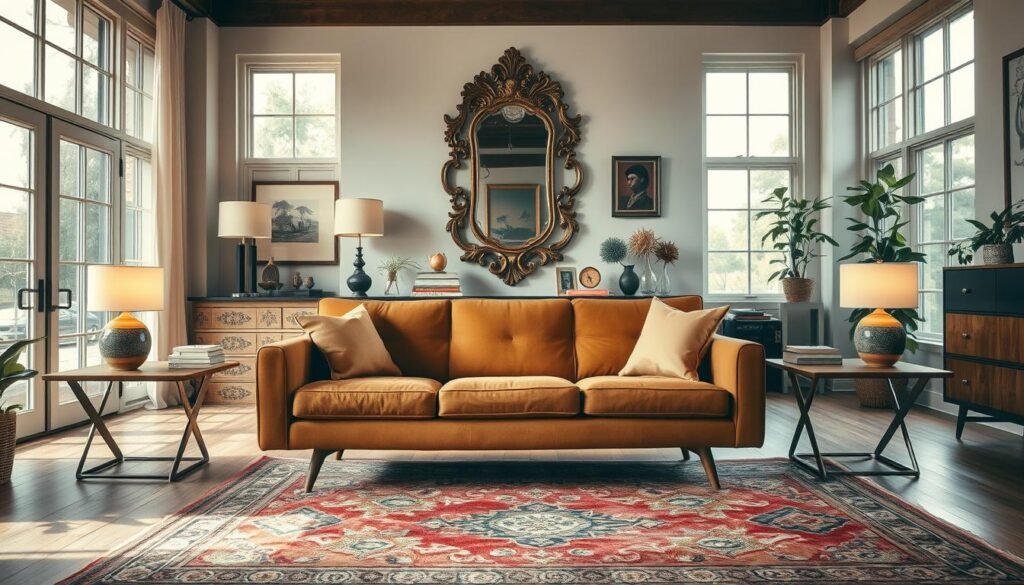
The secret to timeless design? It’s all about tension—the spark that happens when aged textures meet sleek surfaces. Like a handwritten letter sealed with a digital wax stamp, this blend creates spaces that feel both grounded and fresh.
Pairing Vintage Pieces with Neutral Colors
Neutral walls act like gallery walls for your favorite finds. Soft greys or warm ivories let that carved wooden mirror or enamel sign take center stage. Think of colors as volume knobs: bold reds shout, while muted tones whisper, “Look closer.”
Why does this work? Light blues mirror faded denim’s comfort. Creams echo aged paper’s warmth. These hues create calm backdrops so your 1940s typewriter or mid-century lamp becomes the main character.
Using Modern Materials to Mimic Historical Charm
Today’s tech lets you capture yesterday’s magic without the upkeep. Polyurethane crown molding weighs 80% less than plaster but looks identical. Porcelain tiles now replicate worn brick so convincingly, even contractors do double-takes.
Try these swaps:
- Countertops: Laminate with marble veining (no sealing required)
- Wall accents: Peel-and-stick tin-look tiles (rental-friendly)
- Lighting: LED candles in brass candlesticks (flame-free ambiance)
One designer client framed her great-grandmother’s lace tablecloth behind UV-protective glass—preserving history while dodging dusting. That’s the sweet spot: honoring the past while embracing today’s conveniences.
Curating Your Favorite “vintage decor ideas”

Your home becomes a gallery of stories when you blend heirlooms with clever finds. The trick? Seeing potential in everyday objects and giving them new roles. Let’s explore how to spotlight pieces that spark joy and dialogue.
Repurposing Family Treasures and Thrifted Finds
Those paint-by-number landscapes gathering dust? Frame them in sleek black borders for instant gallery walls. Brass animal figurines become whimsical bookcase accents when grouped in odd numbers. As designer Lila Monroe advises:
“The best collections look curated, not cluttered—leave breathing room between pieces.”
Lighting doubles as art with mid-century lamps. Their warm glow highlights textured shades while serving as sculptural elements. Try pairing one with a modern side table—the contrast makes both shine.
| Item | Unexpected Use | Style Tip |
|---|---|---|
| 1932 trophies | Entryway key holders | Polish only the engraving |
| Rolling pins | Kitchen curtain rods | Add vintage tea towels |
| Transferware pitchers | Bathroom storage | Mix with white towels |
Old books get fresh purpose wrapped in linen or stacked as side tables. For kitchen charm, display a sifter holding herbs near white cabinets. The galvanized metal adds rustic contrast without clutter.
Glassware collections shine when arranged by color in open shelving. Start with three matching pieces, then build outward. You’ll create rhythm while letting each item’s uniqueness stand out.
Conclusion
Creating a character-filled home isn’t about following trends—it’s about weaving your narrative into every corner. Those chipped teacups from flea markets? They’re not just dishes. They’re invitations to slow down and savor moments, blending sustainability with soul.
You get to decide what stays. That mid-century chair with worn arms stays because it makes you smile—not because some design rule says so. Trust your gut. If an item whispers “keep me,” listen. If it feels like clutter, let it go.
Hunting for treasures teaches valuable skills. You’ll learn to spot quality stitching under dust or see potential in faded wood. This discernment turns shopping into storytelling—each find adds chapters to your space’s evolving tale.
Best part? Building this look costs less than buying new. That hand-stitched quilt from a garage sale becomes a wall hanging. Mismatched plates create eclectic charm. Every choice supports the circular economy while making your rooms unforgettable.
Start small. Pick one item that speaks to you—a frame, a vase, a textile. Let it guide your next steps. Before long, you’ll craft spaces that feel like living scrapbooks, rich with meaning and utterly yours.

